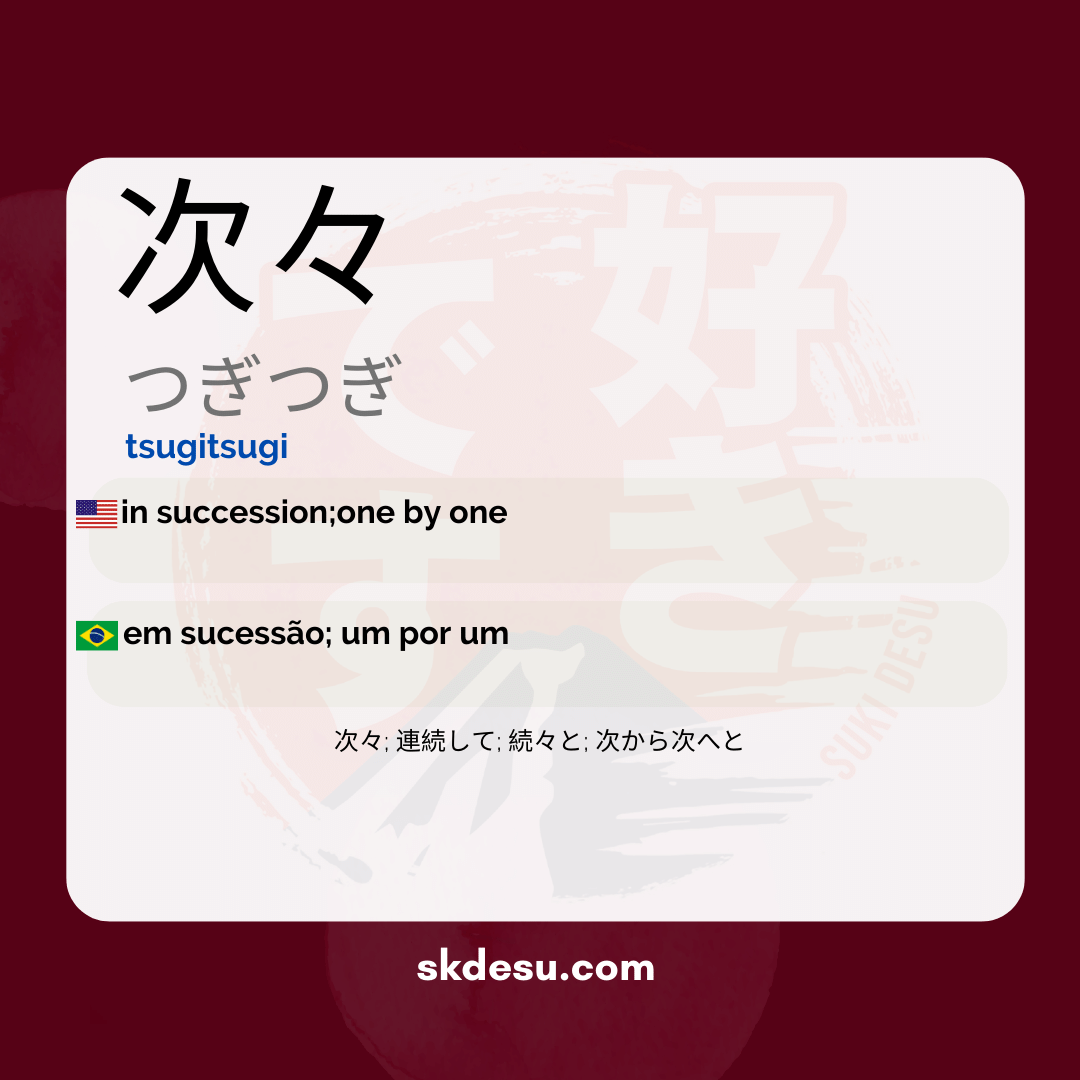Translation and Meaning of: 次々 - tsugitsugi
The Japanese word 次々 (つぎつぎ) is a term that describes a continuous sequence of events or actions, often conveying the idea of something happening "one after another" or "successively." If you are studying Japanese or are curious about expressions that describe flow and continuity, understanding the meaning and use of this word can enrich your vocabulary. In this article, we will explore its origin, everyday applications, and even tips for memorizing it effectively.
In addition to being useful in everyday conversations, 次々 also frequently appears in Japanese media, such as animes and dramas, reinforcing its relevance for language learners. If you've ever wondered how the Japanese describe situations where things happen in quick succession, this expression is one of the keys to understanding that context. Let's dive into the details so you can use it with confidence.
Meaning and usage of 次々 (つぎつぎ)
次々 is an adverb that indicates a continuous sequence of events, objects, or actions. It can be translated as "one after another," "successively," or "in rapid succession." For example, if several people enter a room without a break, you can describe the scene with 次々. This word is particularly useful in contexts where there is constant movement or change.
In the Japanese language, 次々 is often used in everyday situations, such as describing dishes arriving at a restaurant, news piling up, or even tasks that need to be completed without pause. Its versatility makes it a valuable expression for those who want to sound more natural when speaking Japanese. Moreover, it does not carry negative or positive connotations by itself – everything depends on the context in which it is used.
Origin and structure of 次々
The word 次々 is formed by the repetition of the kanji 次 (つぎ), which means "next" or "following." This duplication is common in Japanese to emphasize continuity or repetition, as in other words like 時々 (ときどき – "sometimes") or 段々 (だんだん – "gradually"). The repetitive structure helps reinforce the idea that something is happening without interruption.
Although there are no precise historical records on when 次々 emerged, its use is established in modern Japanese. The simplicity of the construction – a repeated kanji – makes it easier to memorize, especially for students who are already familiar with the concept of repeating characters to create adverbs. This feature makes the word more accessible for those learning the language.
Tips to memorize and use 次々
An effective way to memorize 次々 is to associate it with visual or auditory situations. Imagine a line of people entering a place without stopping, or a series of events unfolding quickly. Mentally creating these images can help you remember the meaning whenever you hear or read the word. Another tip is to practice with simple sentences, such as "ニュースが次々と入ってくる" (the news is coming in rapid succession).
In addition, paying attention to the use of 次々 in animes, dramas, or even in Japanese news reports can solidify your understanding. The word often appears in dynamic contexts, such as action scenes or situations with a lot of activity. The more you encounter it in authentic materials, the more natural its use will be in your own Japanese.
Vocabulary
Expand your vocabulary with related words:
Synonyms and similar words
- 次々 (tsugitsugi) - One after the other, in sequence, indicating continuity.
- 連続して (renzoku shite) - Continuously, without interruptions.
- 続々と (zokuzoku to) - One after another, in a quick sequence, often used in contexts where something is coming or happening in mass.
- 次から次へと (tsugi kara tsuge to) - From one to another, successively highlighting the transition from one item or event to the next.
Related words
Romaji: tsugitsugi
Kana: つぎつぎ
Type: adverb
L: jlpt-n3
Translation / Meaning: in succession; one by one
Meaning in English: in succession;one by one
Definition: Go ahead quickly. Proceed in sequence and follow one after the other.
Quick Access
- Vocabulary
- Writing
- Sentences
How to Write in Japanese - (次々) tsugitsugi
See below a step-by-step guide on how to write the word by hand in Japanese. (次々) tsugitsugi:
Example Sentences - (次々) tsugitsugi
See below some example sentences:
Tsugitsugi ni atarashii aidea wo dashite iku
We will give new ideas one after another.
- 次々に - adverb that indicates a consecutive action, one after the other;
- 新しい - adjective meaning "new";
- アイデア - noun meaning "idea";
- を - particle that indicates the direct object of the sentence;
- 出していく - compound verb meaning "to launch, present" and "to continue doing something in the future."
Other Words of this Type: adverb
See other words from our dictionary that are also: adverb

